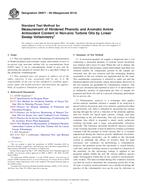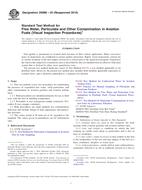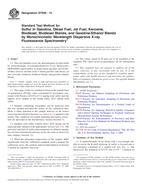Potřebujeme váš souhlas k využití jednotlivých dat, aby se vám mimo jiné mohly ukazovat informace týkající se vašich zájmů. Souhlas udělíte kliknutím na tlačítko „OK“.
ASTM D6730-01(2011)
Standard Test Method for Determination of Individual Components in Spark Ignition Engine Fuels by 100-Metre Capillary (with Precolumn) High-Resolution Gas Chromatography
Automaticky přeložený název:
Standardní zkušební metoda pro stanovení jednotlivých komponent Spark paliv spalovacím motorem 100-Metrické kapilární (s Předkolona) s vysokým rozlišením plynové chromatografie
NORMA vydána dne 1.5.2011
Informace o normě:
Označení normy: ASTM D6730-01(2011)
Poznámka: NEPLATNÁ
Datum vydání normy: 1.5.2011
Kód zboží: NS-36302
Počet stran: 55
Přibližná hmotnost: 165 g (0.36 liber)
Země: Americká technická norma
Kategorie: Technické normy ASTM
Kategorie - podobné normy:
Anotace textu normy ASTM D6730-01(2011) :
Keywords:
detailed hydrocarbon analysis, DHA, gas chromotography, hydrocarbons, open tubular column, oxygenates, PIONA, PONA, Automotive engine fuels/oils, Calibration--petroleum analysis instrumentation, Column tests, Composition analysis--petroleum products, Detailed hydrocarbon analysis (DHA), ETBE (ethyl tert-butyl ether), Final column temperature, Gas chromatography (GC)--petroleum products, High-resolution gas chromatography (GC), Hydrocarbons (aromatic), MTBE (methyl tert-butylether)
Doplňující informace
| Significance and Use | ||||||||||||||||||||||||||||
|
Knowledge of the individual component composition (speciation) of gasoline fuels and blending stocks is useful for refinery quality control and product specification. Process control and product specification compliance for many individual hydrocarbons can be determined through the use of this test method. This test method is adopted from earlier development and enhancement. , , , The chromatographic operating conditions and column tuning process, included in this test method, were developed to provide and enhance the separation and subsequent determination of many individual components not obtained with previous single-column analyses. The column temperature program profile is selected to afford the maximum resolution of possible co-eluting components, especially where these are of two different compound types (for example, a paraffin and a naphthene). Although a majority of the individual hydrocarbons present in petroleum distillates are determined, some co-elution of compounds is encountered. If this test method is utilized to determine bulk hydrocarbon group-type composition (PONA), the user of such data should be cautioned that some error will be encountered due to co-elution and a lack of identification of all components present. Samples containing significant amounts of olefinic or naphthenic, or both, constituents above octane may reflect significant errors in PONA-type groupings. If water is or is suspected of being present, its concentration is determined by the use of Test Method D1744. Other compounds containing oxygen, sulfur, nitrogen, and so forth may also be present, and may co-elute with the hydrocarbons. When known co-elution exists, these are noted in the test method data tables. If determination of these specific compounds is required, it is recommended that test methods for these specific materials be used, such as Test Method D4815 and D5599 for oxygenates, Test Method D5580 for aromatics, and Test Method D5623 for sulfur compounds. |
||||||||||||||||||||||||||||
| 1. Scope | ||||||||||||||||||||||||||||
|
1.1 This test method covers the determination of individual hydrocarbon components of spark-ignition engine fuels and their mixtures containing oxygenate blends (MTBE, ETBE, ethanol, and so forth) with boiling ranges up to 225°C. Other light liquid hydrocarbon mixtures typically encountered in petroleum refining operations, such as blending stocks (naphthas, reformates, alkylates, and so forth) may also be analyzed; however, statistical data was obtained only with blended spark-ignition engine fuels. 1.2 Based on the cooperative study results, individual component concentrations and precision are determined in the range from 0.01 to approximately 30 mass %. The test method may be applicable to higher and lower concentrations for the individual components; however, the user must verify the accuracy if the test method is used for components with concentrations outside the specified ranges. 1.3 This test method also determines methanol, ethanol, t-butanol, methyl t-butyl ether (MTBE), ethyl t-butyl ether (ETBE), and t-amyl methyl ether (TAME) in spark ignition engine fuels in the concentration range from 1 to 30 mass %. However, the cooperative study data provided insufficient statistical data for obtaining a precision statement for these compounds. 1.4 Although a majority of the individual hydrocarbons present are determined, some co-elution of compounds is encountered. If this test method is utilized to estimate bulk hydrocarbon group-type composition (PONA), the user of such data should be cautioned that some error will be encountered due to co-elution and a lack of identification of all components present. Samples containing significant amounts of naphthenic (for example, virgin naphthas) constituents above n-octane may reflect significant errors in PONA-type groupings. Based on the gasoline samples in the interlaboratory cooperative study, this test method is applicable to samples containing less than 25 mass % of olefins. However, some interfering co-elution with the olefins above C7 is possible, particularly if blending components or their higher boiling cuts such as those derived from fluid catalytic cracking (FCC) are analyzed, and the total olefin content may not be accurate. Annex A1 of this test method compares results of the test method with other test methods for selected components, including olefins, and several group types for several interlaboratory cooperative study samples. Although benzene, toulene, and several oxygenates are determined, when doubtful as to the analytical results of these components, confirmatory analyses can be obtained by using the specific test methods listed in the reference section. 1.4.1 Total olefins in the samples may be obtained or confirmed, or both, if necessary, by Test Method D1319 (volume %) or other test methods, such as those based on multidimentional PONA-type of instruments. 1.5 If water is or is suspected of being present, its concentration may be determined, if desired, by the use of Test Method D1744 or equivalent. Other compounds containing oxygen, sulfur, nitrogen, and so forth, may also be present, and may co-elute with the hydrocarbons. If determination of these specific compounds is required, it is recommended that test methods for these specific materials be used, such as Test Methods D4815 and D5599 for oxygenates, and Test Method D5623 for sulfur compounds, or equivalent. 1.6 The values stated in SI units are to be regarded as standard. No other units of measurement are included in this standard. 1.7 This standard does not purport to address all of the safety concerns, if any, associated with its use. It is the responsibility of the user of this standard to establish appropriate safety and health practices and determine the applicability of regulatory limitations prior to use. |
||||||||||||||||||||||||||||
| 2. Referenced Documents | ||||||||||||||||||||||||||||
|
Podobné normy:
Historická
1.5.2014
Historická
1.5.2013
Historická
1.7.2010
Historická
1.6.2010
Historická
15.9.2013
Historická
1.5.2010



 ASTM D6971-09(2014)..
ASTM D6971-09(2014).. ASTM D6974-09(2013)e..
ASTM D6974-09(2013)e.. ASTM D6986-03(2010)..
ASTM D6986-03(2010).. ASTM D7011-10a
ASTM D7011-10a ASTM D7039-13
ASTM D7039-13 ASTM D7041-04(2010)e..
ASTM D7041-04(2010)e..
 Cookies
Cookies
